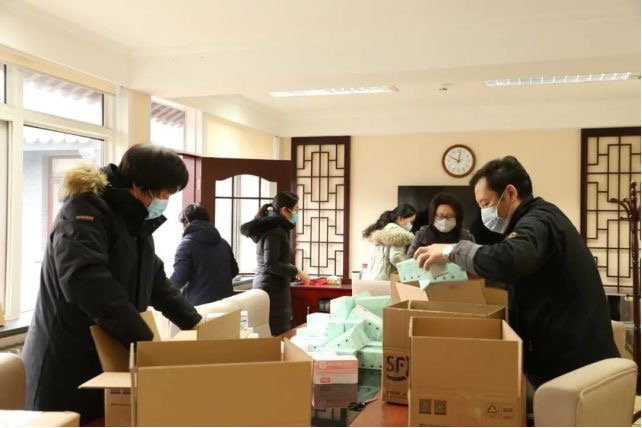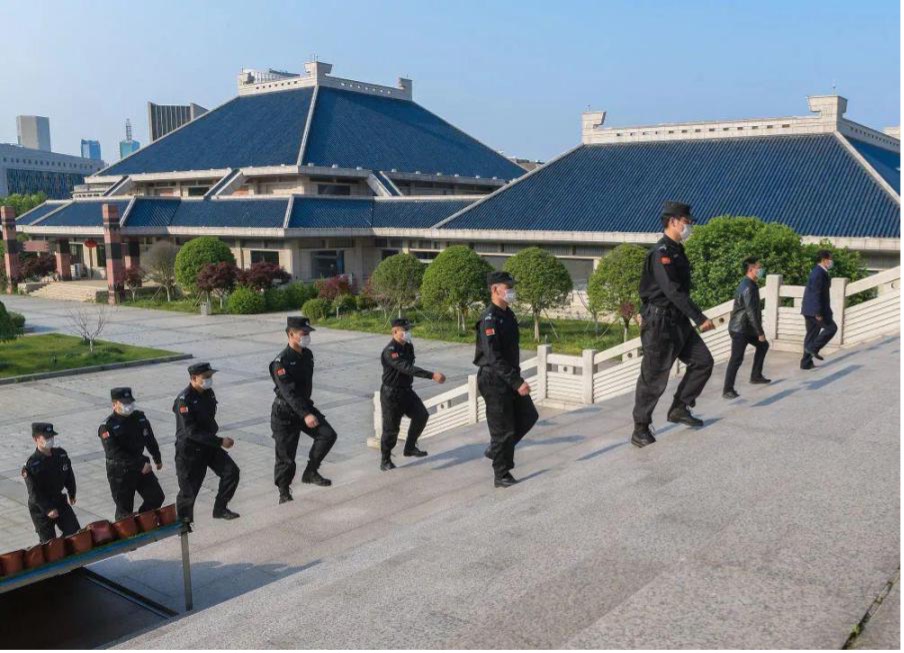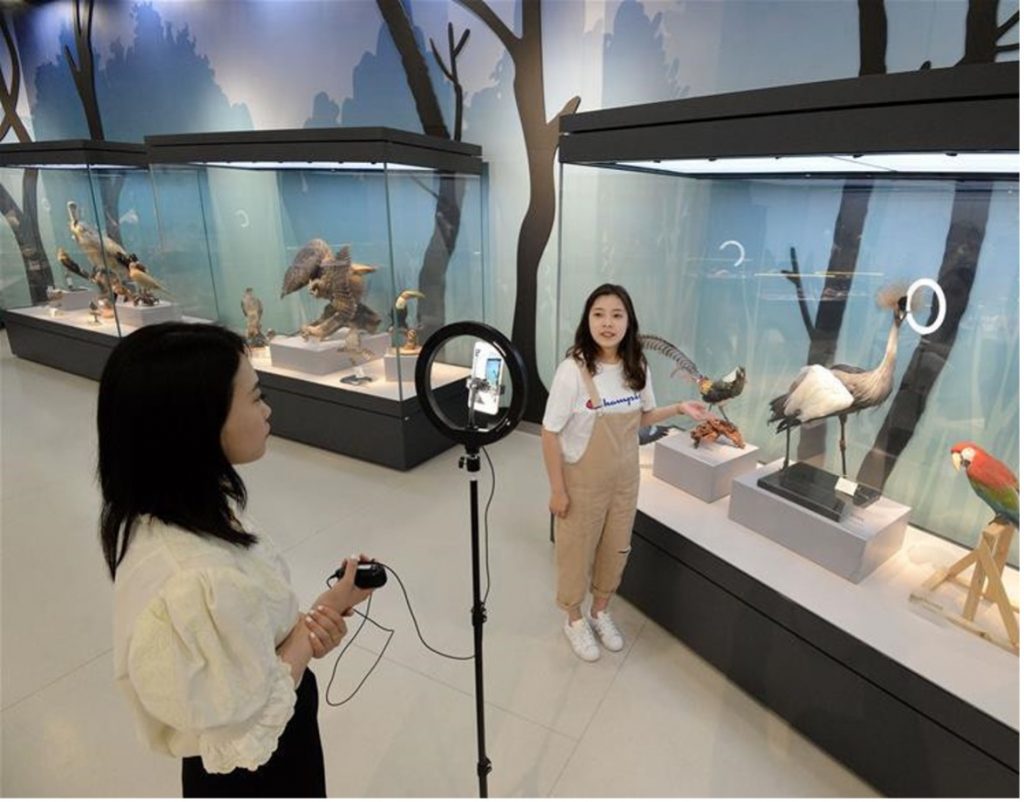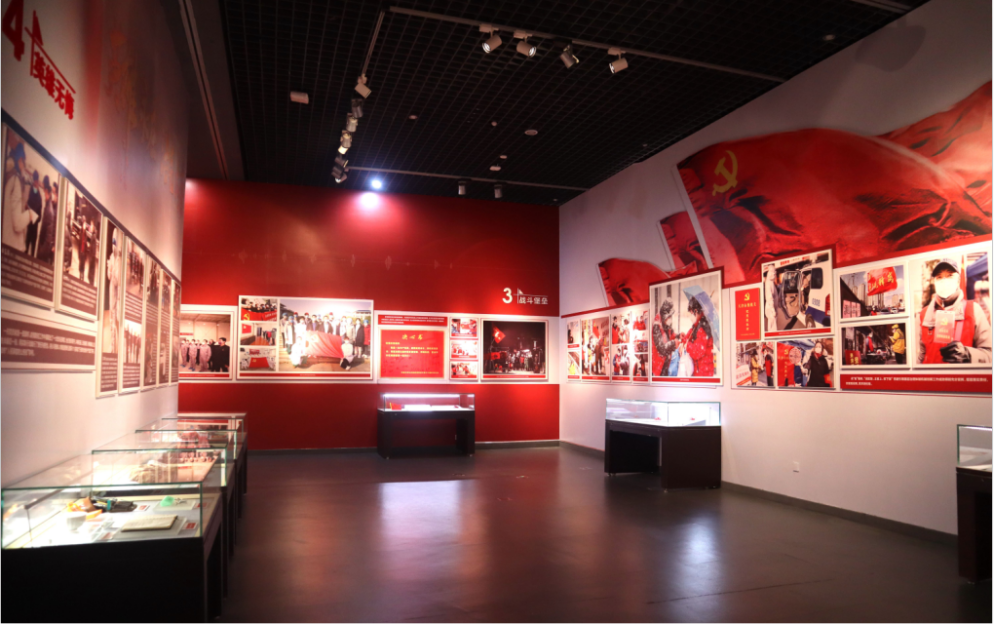
August 7, 2021
Countermeasures Taken by Chinese Museums in the COVID-19 Pandemic Situation and Future Issues
Liu Yang
Curator,
Nankai University Museum, China
1. Introduction
Transmission of COVID-19 began increasing in China from the end of 2019. After this, the virus spread to various countries and regions, and the situation escalated to a global pandemic. Starting in January 24, 2020, 5,354 museums across China issued notices of temporary closure one after another. Museums began offering online services via online exhibitions and livestreaming. This was in accordance with the government agency’s basic policy of continuing online services without interruption even during closure. On February 27, with the momentum of the spread of COVID-19 beginning to ease, China’s National Cultural Heritage Administration published its “国家文物局関於新冠肺炎防控期間有序推進文博単 位恢復開放和複工的指導意見”(Guidelines for the Reopening of Museums).[1] Museums across China gradually reopened in accordance with this policy. China’s museum community then entered a new phase of its efforts to prevent the spread of infection.
This report introduces initiatives taken by the Chinese museum community to prevent the spread of COVID-19, as well as highlighting issues that will need to be addressed going forward. It is hoped that this report may be of some use as a reference for the museum community in Japan, as well as in other countries and regions around the world.
2. Initiatives by the Chinese Museum Community
2.1 Providing online services
During the COVID-19 pandemic, the China government agency responsible for administrating museums established a basic policy of conducting online exhibitions and continuing services without interruption during closure. As such, more than 2,000 online digital exhibitions were held.

China’s National Cultural Heritage Administration selected 300 items from among these and made them available on a dedicated platform for showcasing online museum exhibitions.[2] The exhibitions were produced by 185 museums in 31 provinces (equivalent to prefectures in Japan) across China. The breakdown of exhibition content was as follows: 175 exhibitions (58% of the total) related to history; 67 (22%) related to the arts; 14 (5%) related to the natural sciences; and 15 (15%) related to other topics.[3] On February 1, 2021, the State Council of the People’s Republic of China added this Museum Online Exhibition Platform to its National Administrative Information Disclosure Platform, positioning it as one of ten core services offered to the public during the COVID-19 pandemic. The online digital exhibitions were so well received that the platform was accessed five billion times during the Chinese New Year vacation period alone (January 24 to February 2).[4]
Another online service that has grown in popularity during the pandemic is livestreams by museums—a new service that reveals to some extent the trend toward museum digitalization. According to one report, approximately 30 museums, including the National Museum of China, the Palace Museum, the Nanjing Museum, the Henan Museum, and the Tianjin Museum conducted live broadcasts during the pandemic, using livestreaming platforms such as TikTok, Taobao, Tencent, and KuaiShou. To provide livestreaming on multiple platforms, explanations on the history of cultural properties were given not only by commentators and cultural relics experts, but also by the directors of some of the museums.[5]

In addition, museums across China have focused on innovation in their approaches to information distribution and promotion, aiming to make the cultural experiences of their collections available to the entire public. Strategies include using WeChat and Weibo to automate content distribution, producing and distributing museum-related TV shows, and developing online games. Table 1 provides an overview of some of the livestreams.
Table 1: Overview of Museum Livestreams[6]
| No. | Event Name | Timing | Museum name | Platform | Livestream Content | Access/Views |
| 1 | “Take a Trip the Museum from Home using the Internet” | From February 20 | National Museum of China, Dunhuang Institute, Nanjing Museum, Hunan Provincial Museum, Zhejiang Provincial Museum, Liaoning Provincial Museum, Shandong Provincial Museum, Shanxi Provincial Museum, Guangdong Provincial Museum | TikTok | With technologies such as 3D panoramas, augmented reality (AR), virtual reality (VR), and livestreaming, audiences can visit the museum and see various valuable cultural assets from the comfort of home. | |
| 2 | “The Museum is Right Beside You” | Three to four times per week; 27 times in total during the period from February 26 to March 19. | Beijing Western Zhou Yandu Site Museum, Beijing Stone Carving Art Museum, Civil Aviation Museum, Chinese Film Museum, Beijing Olympic Museum, Beijing Ancient Architecture Museum | Museum experts, scholars, and commentators take Internet users along with them to visit museums and explain cultural assets. | Viewership reached on average 200,000 viewers per episode, sometimes as high as 500,000. | |
| 3 | “Explore National Treasures Online” | Nine sessions over three days from March 2 to March 4; total of 530 minutes. | Henan Museum, Qinghai Provincial Museum, Sichuan Museum, Gansu Provincial Museum, Ningxia Museum, Inner Mongolia Museum, Shaanxi History Museum, Shanxi Museum, Shandong Museum, etc.; nine museums along the Yellow River | Tencent | Through the “Treasures of Zhenguan,” a talk about Yellow River culture, in its past and present generations. | A total of 12.53 million viewers. |
| 4 | “No Talk of Relics—Just Listening, Waiting for the Recovery” | Total of six sessions held from March 31 to April 5. | Hubei Provincial Museum | Starting from the precious cultural assets owned by the Hubei Provincial Museum, this project featured specially invited star guests, each one chosen for their fit with the perceived character of a certain cultural asset. These “cultural asset vocalizers” provided interpretations of the cultural assets in five-minute video clips. | 115.9 million views. | |
| 5 | “Quiet Palace, Beautiful Spring Sun” | Three times in total, from April 5 to April 6. | The Palace Museum | Xinhua, Xinhuanet, People’s Daily, etc. | The three live feeds took three different routes to experience the beautiful scenery of the Palace Museum during its closure. The feeds covered the scenery of the west, middle and east streets, as well as the three different times of day: morning, afternoon and evening. | The live broadcast on Xinhuanet drew a total of 34.92 million viewers and received about 60,000 comments. |
2.2 Fulfilling social responsibility and helping prevent the spread of infection
During the pandemic, employees of museums in Hubei Province, Henan Province, Shanghai City, and Tianjin City cooperated with government officials to conduct an interview-based survey, registering movements in and out of residential communities, recording body temperatures, and documenting records of infection. 王暁東 (Wang Xiaodong?), director of the Cultural Relics Administration of Tianchang City in Anhui Province, became ill and died of a myocardial infarction due to long hours spent working on preventative measures against COVID-19. Driven by a sense of social responsibility and mission, hundreds of museums, including privately owned museums, sent donations and donated medical equipment to Hubei Province, the so-called epicenter of the COVID-19 pandemic, with the encouragement of the National Cultural Heritage Administration.
In order to promote infection prevention measures, the Science Museum of China produced and published a picture book titled “科学 開開門:給小朋友的新冠状病毒感染防護絵本” (a children’s book explaining measures for COVID-19 prevention).
In addition, the Shaanxi History Museum published a cartoon in the People’s Daily, “The Tang Dynasty Series Epidemic Prevention Chart” (a chart presenting COVID-19 prevention measures using illustrations inspired by the Tang Dynasty). 陳嶬, a museum curator in Tongling City, Anhui Province, produced a song called “永不言敗” (“We Will Never Lose”), which was picked up by more than 20 media outlets, including Xinhua Net. In addition, many museums announced that following reopening they would offer long-term preferential services to medical personnel.[7]
2.3 Reopening buildings in an orderly manner with strict implementation of prevention measures
On February 27, 2020, with the spread of COVID-19 under control, China’s National Cultural Heritage Administration published its “国家文物局䎔于新冠肺炎疫情防控期间有序 推进文博单位恢䐾䇖放和䐾工的指导意见”1(Guidelines for the Reopening of Museums) and issued the following instructions to its relevant departments:
(1) Open museums sequentially following thorough implementation of measures based on segmentation by region, type, and scale;
(2) Require advance online reservation by name and avoid crowding by controlling overall visitor numbers and allocating separate time slots for visits;
(3) Continue to provide quality digital cultural content and services online;
(4) Use the space outside the museum to create display boards and walls for promoting and disseminating COVID-19 prevention measures.
Local cultural heritage administrations also subsequently developed their own guidelines, including controls on the number of visitors by time slot, limitations on the scope of tourist activities. These were applied when the museums reopened. Provinces such as Shanxi, Shandong, Guizhou and Henan have established regulations to limit the number of visitors at tourist attractions to 50% of the normal daily maximum. To reduce the risk of infection from human-to-human contact, the Henan Longmen Grottoes Scenic Area has introduced a system of online advance reservation, online ticket sales, and facial recognition or QR code entry. The Shaanxi provincial government is encouraging museums and memorial halls to use digital tools such as audio guides and smartphone apps. The Yunnan provincial government requires strict limitations on the numbers of people gathering in the rooms of management agency facilities at tourist attractions, with a minimum distance of 1.5 meters between people. In addition, each venue is required to take visitors’ temperatures before entering, enforce the wearing of masks, and disinfect on a regular basis.[8]
2.4 Creating a record for the future
On March 18, 2020, the State Administration of Cultural Relics issued the “関於新冠肺炎疫情防控代表性見証物徴集和保存的通知” (Notice on the Collection and Preservation of Evidence of Measures to Prevent the Spread of COVID-19).
The notice positioned the collection, organization, and preservation of materials concerning the spirit of the people and the memory of the times as an important mission of museums. The notice thus instructed museums to fulfill their social responsibilities in this respect, carrying out their collection and preservation activities in an orderly manner while also playing their own part in implementing measures prevent the spread of the virus.[9]
Based on this notice, museums across the country began to call for the submission of relevant materials. Materials, whether in the form of actual objects, videos, photographs, written materials, or artifacts, are mainly of the following types:[10]
(1) Original documents such as executive orders, notices, and proposals issued by the government and related agencies;
(2) Medical supplies, written records, and photographic materials used by medical personnel (local and support units);
(3) Donation records and related materials from various organizations, groups, and individuals;
(4) Minutes, equipment, tools, and photographic materials of the volunteer activities of citizens and Communist Party officials;
(5) Weekly reports from government agencies and employees of state-owned enterprises during the pandemic, written records and photographic materials related to measures to prevent the spread of infection in each community, as well as supplies (admission cards, registration sheets, thermometers, armbands, banners, etc.);
(6) Moving images, calligraphy, paintings, and calligraphic works on the theme of the fight against COVID-19;
(7) Other related items and materials.

With the collection of related materials, many museums held exhibitions and displayed episodes of the battle with COVID-19. National Museum of China held an exhibition entitled “剣志成城――抗疫主題美術作品展” (“If we all work together, we can overcome any difficulties”). The Guangzhou Provincial Museum held an exhibition called “剣志成城――致敬抗疫者” (“For those fighting against COVID-19”).
陳履生(Chen Lisheng?), former deputy director of the National Museum of China, called for the construction of a national quarantine museum. Chen said that the purpose of establishing a national quarantine museum was to bear witness to the COVID-19 outbreak and the combined efforts of people across the country to fight the virus, as a means to educating people about and recording the history of the disease control measures. This proposal was disseminated through the mass media and gained widespread support from the public.
3. Future Issues to be Addressed
3.1 Further strengthen ability to respond to sudden public incidents
Ensuring the safety of people and cultural properties in any emergency situation is the most important responsibility of museum personnel. In the early days of the COVID-19 epidemic, museums across the country, especially those in areas with high caseloads, suffered from shortages of quarantine supplies. When the Hubei Provincial Museum tried to call for emergency assistance nationwide, few museums were able to provide immediate support with the provision of supplies. Many museums took a long time to gradually replenish quarantine supplies due to the extreme shortages. Museums therefore need to take daily measures to ensure adequate preparedness for an emergency, in terms of staffing, technology, supplies, and equipment. Some have suggested that the museum’s minimum emergency stockpile should ordinarily be listed and managed as part of the museum’s fixed asset items. Such goods need to be included in the government’s macro-control goods list. Government-led procurement and mediation are also important.

3.2 Avoid excessive emphasis on visitor numbers
From 2008, the Chinese government began advocating free access to museums and memorials nationwide. The number of visitors to the museum has increased dramatically as a result, but for museums where many people are often crowded together, a sudden public incident can have extremely frightening consequences. In addition, the rapid increase in the number of visitors has overwhelmed museum staff and certain facilities, which has affected the visitor experience. In the future, such measures as online reservations by name, restrictions on visitor numbers, allocation of time slots, digital guides, etc., will become the norm. This will help to prevent situations where many people are crowded into a museum for a long time, which will in turn lead to the improvement of service quality.
3.3 Further improve the quality of online services
During the pandemic, while museums did hold many online exhibitions, some of these failed to leverage fully the strengths of online technology, instead merely providing digital versions of offline exhibits. In addition, some of the online exhibitions had problems such as difficulty in viewing photos and panels of cultural properties or difficulty in understanding explanations because they were too short. This left viewers unable to fully appreciate them. In one museum’s livestream, some commentators said that some of the explanations were not sensitive enough to the psychological state of people during the pandemic, which made it difficult to understand. For example, the copy “Let’s enjoy the museum on the Internet while staying at home,” sounded like a light-hearted pun. This was difficult to accept for many citizens, who were suffering from stress due to the pandemic. It cannot be underestimated the extent to which a lack of sensitivity can damage a museum’s reputation or trigger distrust in its services.11 Improving the quality of online services is therefore a challenge that museums will have to face in the future.
3.4 Important to continue using mass media alongside new media
During the pandemic, museums achieved extremely positive results by providing various online services and promotional activities through new media such as their official websites, Weibo, and WeChat. However, it is also necessary to consider the elderly and children who do not have smart devices. Therefore, future museum promotion and exhibition activities should continue to use traditional mass media such as radio, television, and newspapers. One example of this during the pandemic was a collaboration between the Tianjin Museum and the Tianjin Radio and Television Network to produce a program called “TV Museum.” The program was well received by many elderly people as it featured themes and explanations of the museum’s collection, as well as retrospective videos of important activities.
4. Conclusion
The COVID-19 pandemic has been the fastest spreading, most widespread, and most difficult to prevent and control serious public health incident to occur in China in recent years. In the face of this ordeal, China’s museum community has taken quick and effective measures to bring about positive social effects. However, some problems and areas for improvement have also become apparent. We, as museum professionals, should, at the appropriate time, reflect on the experience and lessons learned from the fight against COVID-19 so that we may strive to improve our modern museum management skills and service level.
(Liu Yang)
[1] National Cultural Heritage Administration 2020 “国家文物局関於新冠肺炎防控期間有序推進文博単位恢復開放和複工的指導意見 “, http://www.gov.cn/zhengce/zhengceku/2020-03/01/ content_5485315.htm, (viewed on August 20, 2020)
[2] The “Museum Online Exhibition Platform” is an Internet platform specially set up on the official website of the National Cultural Heritage Administration, with the aim of integrating the exhibition contents of museums across the country via the Internet and realizing the innovation of museum communications. The access link is as follows: http://virtual.vizen.cn/exhibition/ index.html.
[3] 李晨・耿坤 (Li Chen and Geng Kun?) 2020, “関於博物館数字文化資源開放機制建設的検討」『中国博物館], No. 2, China Museum Association.
[4] Ministry of Culture and Tourism 2020 “春節期間超50万億人次在線観展”, http://news.cctv.com/2020/03/18/ARTIMXv9ntDChCE0xwmWLjt2200318.shtml(viewed on August 20, 2020)
[5] 鄒雅䆾・賀亜楠 2020「博物館直播為何這麼火?」 People’s Daily (Overseas Edition), March 24, 2020
[6] 李晨・耿坤「関於博物館数字文化資源開放機制建設的検討」『中国博物館』China Museum, No. 2, China Museum Association, 2020
[7]『博物院』編集部 2020「博物館と公共事件――国家文物局副局長関強訪談録」『博物院』No. 2, 科学出版社
[8] 李韵 2020「博物館線上服務:防疫展覧両不呉」『光明日報』2020/03/03
[9] National Cultural Heritage Administration 2020 “關於新冠肺炎疫情防控代表性見証物徴集和保存的通知”, http://www.ncha.gov.cn/art/2020/3/31/art_2404_683.html (2020) (viewed on August 20, 2020)
[10] 潘守永 “為了明天収蔵今天–新冠肺炎疫情下的博物館使命与行動邏輯”, China Museum, No. 2, China Museum Association, 2020
[11] 陳卓羅向軍ほか 2020「『博物館と公共事件』主題筆談」『博物院』No. 2, 科学出版社